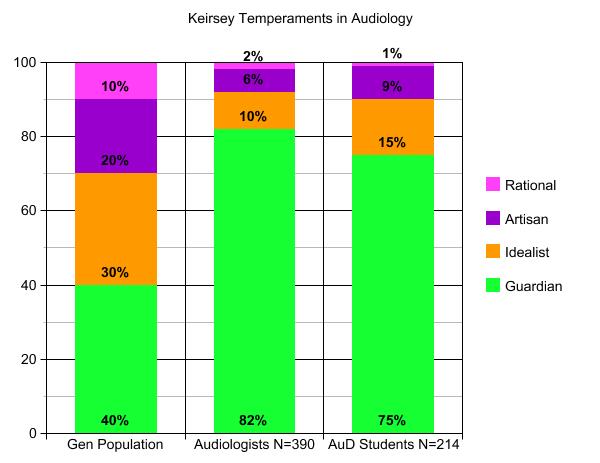 Kris English, PhD
Kris English, PhD
The University of Akron
From 1999-2009, I had the opportunity to teach an online course in counseling for audiologists earning an AuD through the Central Michigan University/Bill Wilkerson Center Vanderbilt University distance education program. It will seem hard to believe now, but when the AuD program started, many enrollees had little experience with email, so to get the ball rolling, the first assignment was to complete the Keirsey temperament questionnaire and email me the results (Rational, Artisan, Idealist, or Guardian). My two goals were to jump-start the “know thyself” process and to help students become familiar with my email address. I wasn’t looking for any trends, but … take a look (updated January 2018):
 Ten years and 25 semesters later, with results from 390 audiologists (all with MA degrees and an average of 15 years experience), the summative data show a very strong tendency toward Guardian temperaments (82% in the middle bar, compared to 40% in the general population on the left). Since then, I have posed the same assignment to AuD graduate students (another 10-year project from 2008 to 2018, right hand bar), and have also frequently asked attendees at workshops to spend 10 minutes on this exercise, with very similar results. For instance, among 27 practitioners in a recent workshop, our results were 0% Rationals, 18% Artisans, 15% Idealists, and 67% Guardians.
Ten years and 25 semesters later, with results from 390 audiologists (all with MA degrees and an average of 15 years experience), the summative data show a very strong tendency toward Guardian temperaments (82% in the middle bar, compared to 40% in the general population on the left). Since then, I have posed the same assignment to AuD graduate students (another 10-year project from 2008 to 2018, right hand bar), and have also frequently asked attendees at workshops to spend 10 minutes on this exercise, with very similar results. For instance, among 27 practitioners in a recent workshop, our results were 0% Rationals, 18% Artisans, 15% Idealists, and 67% Guardians.
“Knowing Thyself” Stimulated Change
Of course, this exercise does not represent rigorous science, but it does given us food for thought. We would expect certain temperaments to be drawn to some professions compared to others. For information on each temperament, visit the Keirsey website; specific to our topic, we learn that Guardians:
- Are given to service and preserving social institutions
- Have a natural talent in managing goods, services
- Keep things running smoothly in families, communities, schools, churches, hospitals, businesses
- Take pride in being dependable and trustworthy
- Believe in law and order… honor customs and traditions … following the rules and cooperating with others…
- Are meticulous about schedules and have a sharp eye for proper procedures
source: https://keirsey.com/temperament-overview/
The four Keirsey Temperaments are aligned with Myers-Briggs results in the table above. A Guardian can be further categorized as Supervisor, Inspector, Provider, or Protector: in other words, someone who assumes responsibility for people and things.
At first I took these results with the proverbial grain of salt, but an intriguing pattern kept emerging. By mid-semester, the distance learners would begin to wonder if their “guardian natures” interfered with patient counseling. They generally agreed that the Guardian characteristics matched their self-perceptions, but in the context of audiology, perhaps being someone who “assumes responsibility of people and things” was actually a problem.
The crucible question seemed to be, “Who owns this hearing loss?” The distance learners (“stand back, I’ll take care of it”) wanted the answer to be “the audiologist owns the hearing loss” by virtue of education and expertise. But our exploration into topics of patient autonomy, the difference between compliance and adherence, and the evidence relating communication styles to patient outcomes (Zolneirek & DiMatteo, 2009) challenged their assumptions of ownership. Thus challenged, Guardians bravely explored patient trust, patient-centered communication, shared decision-making, and health care partnerships – none of which require a Supervisor, Inspector, Provider, or Protector! Their willingness to step out of their comfort zones and test out new ways to “be” with their patients spoke volumes.
The Most Important Instrument?
 Audiologists are surrounded by equipment and technology, so it could be easy to forget this maxim of health care: “The most therapeutic instrument is the self” (Charon, 2001, p. 1899). In addition to keeping our equipment calibrated, we must routinely calibrate ourselves, and be mindful of the impact of our words and body language, our presence in the room, our willingness to share ownership (and its implied power) of a patient’s problems. We do bring training and experience to each patient encounter, but we also bring OURSELVES: temperament as well our commitment and values. From these intangibles, patients decide if we are worthy of their trust.
Audiologists are surrounded by equipment and technology, so it could be easy to forget this maxim of health care: “The most therapeutic instrument is the self” (Charon, 2001, p. 1899). In addition to keeping our equipment calibrated, we must routinely calibrate ourselves, and be mindful of the impact of our words and body language, our presence in the room, our willingness to share ownership (and its implied power) of a patient’s problems. We do bring training and experience to each patient encounter, but we also bring OURSELVES: temperament as well our commitment and values. From these intangibles, patients decide if we are worthy of their trust.
References
Charon, R. (2001). Narrative medicine: A model of empathy, reflection, profession and trust. JAMA, 286(15), 1897-1902.
Zolnierek, K.B., & DiMatteo, M.R. (2009). Physician communication and patient adherence to treatment: A meta-analysis. Medical Care, 47, 826–834.
